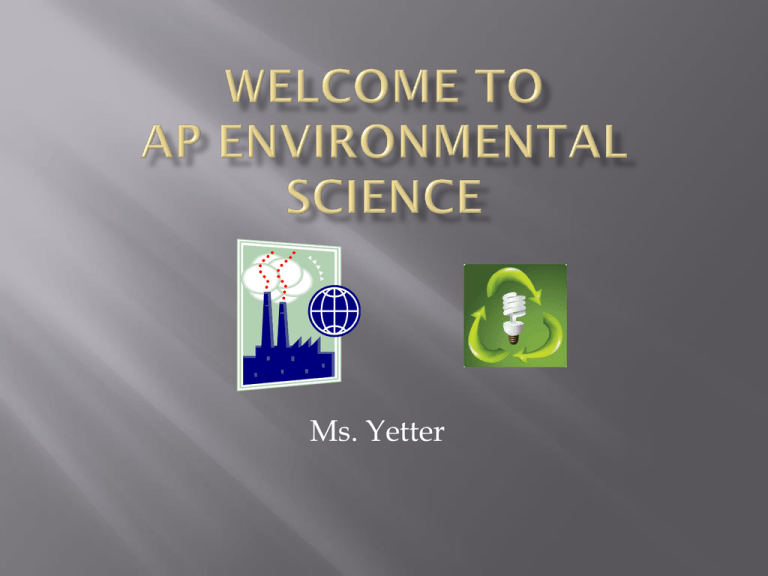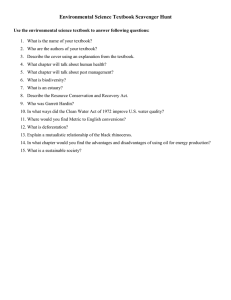AP Environmental Science
advertisement

Ms. Yetter Order of Business Introduction Expectations and Grading Policy Textbook Responsibilities Themes of the Course – Overview Summer Assignments Pill bugs Upon successful completion of this AP Environmental Science course and the AP test, students may be eligible to earn up to four credits of a college laboratory science. Be sure to check with the colleges you are applying to (and ultimately plan on attending), to determine whether they will accept the AP course for credit. Don’t assume: “your mileage may vary” Miller & Spoolman Living in the Environment, 16th edition Textbook Responsibilities – cover them use them at home I’ll let you know when you need to bring them to class keep them safe-- they are expensive and your responsibility What are the causes of the environmental problem? We will look at history, ways of thought, social and economic factors. What is the nature of each problem? We will investigate the science behind each problem. What are the ramifications of each problem? We will look for connections between seemingly unrelated problems. How does one change (the problem) cause other reactions in the environment? What are possible solutions to the problem? What must be changed to solve this problem? Consider ecological, economic, legal and psychological (changes in our way of thinking) factors. We will look at the pros and cons of each possible solution. Science is a process. Science is a method of learning more about the world. Science constantly changes the way we understand the natural world Energy conversions underlie all ecological processes. Energy cannot be created; it must come form somewhere. As energy flows through systems, at each step more of it becomes unusable Earth itself is one interconnected system. Natural systems change over time ansd space. Biogeochemical systems vary in ability to recover from disturbances Humans alter natural systems. Humans have had an impact on the environment for millions of years Technology and population growth have enabled humans to increase both the rate and scale of their impact on the environment. Environmental problems have both a cultural and social context. Understanding the role of cultural, social, and economic factors is vital to the development of solutions. Human survival depends on developing practices that will achieve sustainable systems. A suitable combination of conservation and development is required. Management of common resources is essential. Aka “Rolly-pollies” Look for them under or in anything outside Cool, damp places At least 10 per lab pair Bring them in a closed jar with holes in the lid Of the 6 themes, which one do you think we should emphasize most, and why? (3 complete sentences). Science is a process. Energy conversions underlie all ecological processes. Earth itself is one interconnected system. Humans alter natural systems. Environmental problems have both a cultural and social context. Human survival depends on developing practices that will achieve sustainable systems. Review safety contract Safety equipment in the lab – scavenger hunt! Homework: review safety contract with your parent or guardian, and have him or her sign off acknowledging the rules of the lab have been read. Hand in the signed copy for me to confirm all parties acknowledge the issues; I will return it to you so it can be kept in your notebook for future review.







